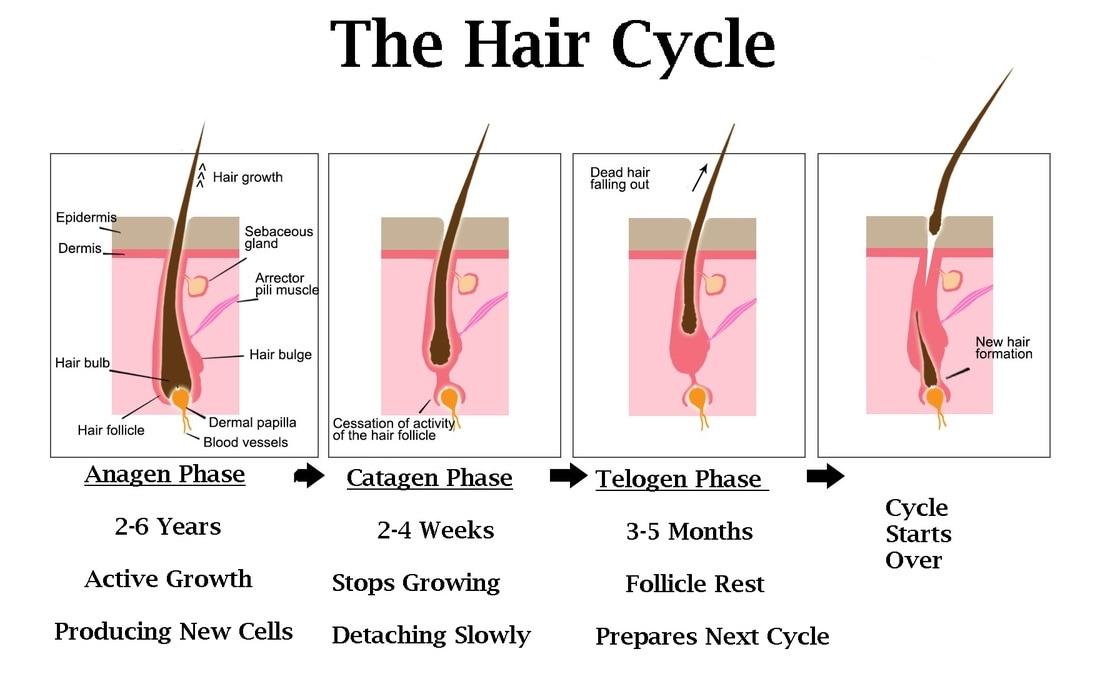
Hair loss or hair fall is the commonest hair and scalp problem. Almost 50% of women experience excessive hair loss at some point in their lifetime. Some amount of daily hair loss is normal about 50 and 100 single strands of hair are shed every day. This amount of hair loss is a part of the hair's natural growth cycle, which occurs in three stages.
-
The Anagen Stage
The active hair growth stage. This stage usually lasts from two to eight years.
-
The Catagen Stage
A short transition phase where hair stops growing and prepares to shed. This stage usually lasts up to three weeks.
-
The Telogen Stage
The expulsion or exfoliation stage. This stage represents that part of the hair cycle when the hair is expelled from the follicle (the structure that produces and holds the hair). Once the hair sheds, the follicle stays dormant, for about three months, after which a new hair starts to sprout.
At any given point normally 85-90% of scalp hair is in the growing (anagen) phase and the rest is in the falling (telogen) phase. When the ratio between the growing and falling phases is disturbed it results in hair loss.
Consult the best hair loss treatment hospital in Hebbal to ensure hair loss is kept under control.

Types and Causes of Hair Loss
Diffuse Hair Loss in Women
-
Nutritional deficiencies
The most common cause of diffuse hair loss in young women is nutritional deficiencies often triggered by fad diets and unhealthy eating habits.
-
Hairstyling
Excessive hairstyling, chemical treatments, or hair colouring all weaken the hair shaft and lead to hair loss.
-
Extreme physical stress
Conditions resulting in extreme physiologic stress such as prolonged illness, a recent surgery, dengue, COVID-19 infection, and other severe viral fevers, can also lead to excessive hair fall.
-
Acute psychological stress
Periods of acute psychological stress also contribute to thinning of hair in women. The excessive hair fall is usually seen 6-8 weeks after the acute period of stress or illness.
Other medical conditions - In other cases, hair loss is triggered by internal problems such as thyroid diseases, autoimmune conditions, recent pregnancy or inflammatory diseases like scalp psoriasis and certain medications.
In all the above-mentioned conditions the percentage of hair in the catagen and telogen phase increases resulting in increased daily shedding of hair and is called Telogen Effluvium. In contrast the sudden hair loss following cancer treatment results from hair falling in the growing phase and is called Anagen effluvium.
Patterned or Patchy Hair Loss
-
Female Pattern Hair Loss or FPHL is the female equivalent of male pattern baldness in women and is seen in women in their forties and fifties. It starts as thinning of hair in the centre of the head which can spread to involve a larger part of the scalp. A genetic predisposition along with hormonal shifts that occur during menopause are the triggers for FPHL.
-
Another cause of patchy hair loss in women is an autoimmune disease condition called Alopecia Areata where recurrent patches of hair loss on the scalp are seen. It may be associated with Vitiligo and thyroid disease.
Treatment of Hair Loss
The treatment for hair loss depends on the underlying condition.
-
For diffuse hair loss, the mainstay of therapy is correcting any underlying nutritional deficiencies, and reducing hair abuse by styling or colouring.
-
The hair loss secondary to a stressful event is usually self-limiting.
-
FPHL is treated with a combination of antiandrogens and minoxidil. Minoxidil is a hair growth promoter, which helps in improving hair loss.
-
Platelet Rich Plasma (PRP) injections into the scalp can improve hair loss in some cases.
-
Alopecia Areata is treated with steroids and other immunomodulatory drugs.
Common Myths About Hair Loss
-
Myth 1
Frequent shampooing causes hair fall.
-
Fact
There is not much evidence to substantiate that frequent shampooing causes hair fall. However, some chemicals in the shampoo may not be ideal for hair health and may cause dry and rough hair if used too frequently.
-
Myth 2
Shaving the head makes the hair grow back twice thick
-
Fact
No. Shaving does not affect hair growth rate or thickness. It is more of an illusion. When you shave your head completely, all the hair grows back simultaneously creating a thick blunt end look which appears as thicker hair. Moreover, with a shaven head, it is easy to notice each millimetre of growth than in an unshaven head, making you believe that hair is growing faster.
-
Myth 3
Standing on your head will increase circulation, stimulating hair growth.
-
Fact
Currently, there is no clinical evidence proving that standing on your head stimulates hair growth or prevents balding.
-
Myth 4
Brushing your hair 100 strokes a day will make them healthier.
-
Fact
Brushing your hair 100 strokes a day does not guarantee you healthier hair. In fact, 100 strokes a day is excessive and unnecessary as it might create friction and can result in cuticle damage or hair breakage.
Consult a dermatologist in Hebbal if you require treatment for hair loss.
Frequently Asked Questions
-
Does stress cause hair loss?
Mild stress may not be a cause for hair loss. However, severe and chronic stress can induce hormonal imbalance and physiological shock leading to hair loss.
-
Are PRP injections effective for hair growth?
Many clinical studies have shown that PRP injections can effectively reduce hair fall and also boost new hair growth.
-
Can acute hair loss be a sign of any other underlying health condition?
Yes. Health conditions such as thyroid disorders, iron deficiency anaemia, malnutrition, hormonal imbalances, etc., may trigger sudden or acute hair loss.



















 5 Min Read
5 Min Read






.png)



